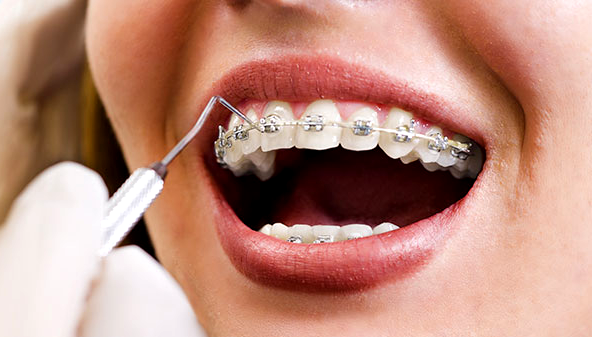WHAT IS ORTHODONTIC TREATMENT?
Orthodontic treatment is a way of straightening or moving teeth, to improve the appearance of the teeth and how they work. It can also help to look after the long-term health of your teeth, gums and jaw joints, by spreading the biting pressure over all your teeth.
Why should I have orthodontic treatment?
Many people have crowded or crooked teeth. Orthodontic treatment will straighten the teeth or move them into a better position. This can improve their appearance and the way the teeth bite together, while also making them easier to clean.

At what age should I have orthodontic treatment?
The best time is generally during childhood, but adults can have orthodontic treatment too – and more and more are doing so. Age is less important than having the right number of teeth. In children it may be necessary to wait for enough teeth to come through before starting treatment.
Who carries out orthodontics?
Your dentist may carry out orthodontic treatment. Or they may send you to a specialist who has extra qualifications. The specialist may be in a practice or in a hospital department, and is called an orthodontist.
What does it involve?
The most important thing is to have a full examination. This will usually involve looking at your teeth, taking dental x-rays and making plaster models of your teeth. Your dental team or orthodontist will then discuss what treatment is possible. Once you are sure you want to go ahead, the treatment can start as soon as you have enough permanent teeth.
What is a removable brace?
Simple treatment may be carried out with a removable brace (a plate that can be taken out to be cleaned). It has delicate wires and springs attached, which move the teeth using gentle pressure.
What is a fixed brace?
Often, teeth need to be guided more accurately than they can be using a removable brace. So a fixed brace is used. This has brackets and bands which are temporarily stuck to the teeth. A flexible wire joins all the brackets and allows the teeth to be moved. You can’t take the appliance out yourself, so it is called a fixed appliance.
Fixed vs. Removable Appliances
Orthodontic treatments could involve fixed or removable appliances. Depending on how severe your situation, your orthodontist will advise you on which approach is the right one for you.
Fixed appliances include:
• Braces – You’ve most likely heard of braces – they’re the most common fixed appliance. They consist of bands, wires, and brackets. How do they work? The bands are the anchors held in place around your teeth. Brackets are attached to the front of your teeth. Arch wires connect the brackets to the bands. Tightening the archwires puts pressure on your teeth, slowly moving them towards their target position. Braces are usually adjusted monthly and are worn for a few months to a few years.
• Special fixed appliances – These should only be used as a last resort to control thumb sucking or tongue thrusting. Since they’re attached to the teeth by bands, they can feel quite uncomfortable while eating.
• Fixed space maintainers – Sometimes, young children lose their teeth prematurely. In such situations, an orthodontist might place a space maintainer in your child’s mouth to keep the space open until a permanent tooth appears.
Removable appliances include:
• Aligners – These are increasingly becoming a popular alternative to traditional braces for adults. Aligners move teeth in the same way as braces, but they are virtually invisible and don’t involve metal wires and brackets. If you’re using them, you need to remove them while eating, brushing, and flossing.
• Removable space maintainers – These devices are used for the same reason as fixed space maintainers. They’re made up of plastic or wire branches and an acrylic base that fits over the jaw. They’re placed in open spaces between teeth to keep the teeth apart.
• Jaw repositioning appliances – These appliances are also known as splints. They’re placed either on the top or lower jaw and are used to treat TMJ disorders by training the jaw to close in a better position.
• Lip and cheek bumpers – Your lip and cheek muscles might exert pressure on your teeth. In such cases, you can use bumpers to keep your lips and cheeks away from the teeth.
• Palatal expander – This device is a plastic plate that fits over the roof of the mouth. It’s used when the arch of your upper jaw needs to be widened.
• Removable retainers – These devices, worn on the roof of the mouth, prevent your teeth from shifting back to their previous position.
• Headgear – These devices slow down the growth of the upper jaw. They also hold the back teeth in place while the front teeth are pulled back.
